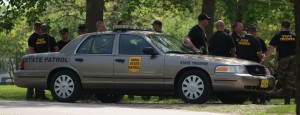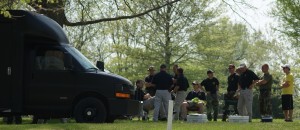Iowa State Patrol and FBI Conduct Drills In Oskaloosa Area

Iowa State Patrol Officers are seen debriefing after their training completed on Monday afternoon (photo D.Hubbard)
The former home of Vennard College played host to the Iowa State Patrol and the FBI as they trained in joint operations on Tuesday.
With nearly 75 members of the State Patrol on hand, including the 4 negotiation teams that consist of 4 to 6 members each and 4 tactical teams consisting of 46 officers, they were “working together in a coordinated effort using a command element so if something was to happen we would be able to resolve something quickly and efficiently with using the least amount of force possible.” said Sgt. Richard Pierce. Pierce is the Assistant District Commander out of Iowa State Patrol District 8 and also Program Coordinator for the Iowa State Patrol’s Crisis Negotiation Program.
“Our overall mission is the preservation of life, because we don’t want anyone to be hurt or killed or anything like that.” Pierce said on why such training is necessary.
Oskaloosa doesn’t seem to be the first place that would come to mind with this type of training, but Pierce says that, “It’s a great training venue to be able to use. What we did here today was we ran 3 simultaneous scenarios that were independent of each other, and our negotiation teams worked with their local area state patrol tactical teams so they could develop a cohesive relationship to be able to resolve the situation.”

Iowa State Patrol Tactical Team members pack up after training Monday on the former Vennard College Campus (photo D.Hubbard)
Scenario’s were run in Bethel, the Administration Building, and the back side of Memorial Hall on the campus. The scenarios required different skill sets to be able to resolve them. Negotiators had to be able to provide Intel and support of the information they were getting, where they would be able to make deliveries that may be requested, and to be able to retrieve any hostages that were released. Snipers were deployed and the use of blank rounds were used by members during the exercise. There were ‘man down’ drills that involved recovery of team members. If there was a suicidal subject, they had to be able to talk them out and resolve it peacefully. 2 FBI negotiators helped to serve as independent moderators for each of the scenarios. Another sergeant, who is the assistant program coordinator, was a moderator for the 3rd scenario.
The scenarios ran for about an hour and a half. They were then followed up by a 20 minute critique that would involve “how do you think you did” and also evaluated them on their abilities to communicate between incident command, negotiation and tactical, their abilities to coordinate negotiations, command and tactical to work cohesively and solve the problem, and how they worked individually within their own units.
Of course, with recent events in Keokuk County, my thoughts turned to this training being in response to that incident. Pierce says this had been in the works for some time already. “This was actually all in the works. I developed it with Lt. Clary, The tactical coordinator. We took a tabletop exercise and then we put it to the field, adding real people to that. I’m bringing in interviews that would be conducted from supposed family members, friends, area canvass, driver license information, as things develop so it would keep the scenarios dynamic .
4 area Iowa State Patrol Lieutenants were on hand as well. They found it very valuable to see how the groups worked. “Part of the scenario involved them being in a stationary point, they couldn’t leave that point. Information had to be brought to them so they could be kept into the mix, rather than them moving around, because if they left their area they would be taken out of the scenario for ten minutes. That would be recreating the fog of war. It can happen if you have a police chief or an incident commander or a sheriff, for example, and they’re out running around because they want to be a part of it. They’re not a part of the command element so they can’t be in the decision making process, so it hinders the entire process. We all like to be a part of it. Those in command have to be in command position. They need to stay in the center of the hub, the center of all the information.” Sgt. Pierce explained.
















